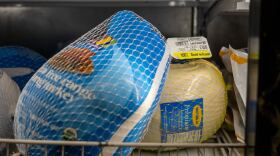Lawmakers return to Juneau later this month to begin the first session of the 34th Alaska Legislature. A new bipartisan caucus made up largely of Democrats and independents will take over the state House, putting it in alignment with the coalition-controlled Senate.
But oil prices are down, and Alaska Public Media’s state government reporter, Eric Stone, said that means there’s less money for lawmakers to spend.
The following interview has been lightly edited for clarity and length.
Eric Stone: The Department of Revenue puts out forecasts every spring and every fall. And on the latest forecast, they're revising down some earlier projections for oil prices.
So as of the end of 2024, Alaska North Slope crude oil is sitting about $73 a barrel. That's what they're forecasting it'll be for the rest of the fiscal year, and that is down a lot from recent years.
In the fiscal year that ended this past June, North Slope crude ran about $85 a barrel. That's basically due to market forces sort of running against each other. Geopolitical uncertainty is pushing prices up. Think about things like the war in Ukraine or instability in the Middle East.
Meanwhile, we're going through an energy transition away from fossil fuels, pushing prices down. You see developed markets like the U.S. leveling off with our oil consumption. Fun fact, the US used less oil in 2023 than it did in 2019. Meanwhile, China's economy is also slowing down.
So oil prices are expected to fall to about $70 a barrel for North Slope crude next fiscal year. That's $4 less than was previously expected. Unrestricted oil revenue – that's the oil money that lawmakers can spend however they would like – that's forecast to come in about $1.7 billion in the next fiscal year. And that is down by more than half from fiscal year 2022, when oil prices spiked after Russia's invasion of Ukraine.
And at this point, the longer term forecast is a little bit rosier. You know, production is forecast to rise significantly by the mid 2030s as you see things like Willow and Pikka, those big projects [that’ll] start producing oil. But even still, 10 years from now, total oil revenue is forecast to be down by more than $350 million from where it is right now.
Honestly, that's just the reality in a world that needs less and less oil to function. Drilling is expensive and difficult in the Arctic. It's a lot easier to quickly ramp up production elsewhere, it just comes with less risk.
Ava White: So less oil revenue, but of course, oil isn’t the only source of state revenue?
ES: The state also leans on the Alaska Permanent Fund to balance the budget. The state takes 5% of the market value of the permanent fund every year and sells it off to use for state services. For the coming year that's forecast to be $3.8 billion, or more than 60% of the revenues the state will receive.
So I mean, we've seen over the years, the permanent fund becoming a bigger and bigger source of state revenue. That could set up some pressure on the fund.
For now, it's looking like a pretty stable source of funding.
Revenue commissioner Adam Crum says we're now what he calls an endowment state because of our reliance on investment revenues like a university or college.
AW: So, less oil money and relatively stable Permanent Fund revenue. Where does that leave lawmakers?
ES: As I said at the top, there's just less money to go around. There's about $220 million less in revenue than was previously expected for this year, and a similar downward revision for next year.
Governor Mike Dunleavy put out his budget. He didn't propose significant cuts to go along with that decline in revenue. His budget would pay nearly $4,000 PFDs, but that would require spending more than half of the primary non-permanent fund savings account state has.
And to do that, that would require a three quarters majority in both the State House and State Senate to pass, since that draws on the constitutional budget reserve. And honestly, that's not likely.
Democrat heavy coalitions control both chambers, so you're probably not going to see the governor's budget pass as is. The governor's budget would also leave public schools with roughly $175 million less than they got this year, though Dunleavy says he's also planning to introduce a, so far unbudgeted education bill.
So all that leaves very little room for new bills that lawmakers might like to pass, in capital spending, things like that.
We can expect some fights over spending and the budget during the session this year, especially over the PFD, which could be lower this year than it has been in prior years, including last year.







